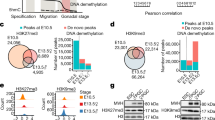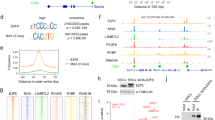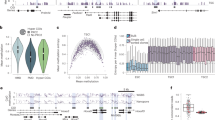Abstract
Epigenetic regulation is essential for temporal, tissue-specific and parent-of-origin–dependent gene expression. It has recently been found that the mouse Polycomb group (PcG) gene Eed (embryonic ectoderm development) acts to maintain repression of the imprinted X chromosome. Here, we investigated whether Eed is also required for regulation of autosomal imprinted loci. Expression analyses showed that transcripts from the silent alleles of a subset of paternally repressed genes were present in Eed−/− embryos. Parent-of-origin methylation was preserved in these embryos, but we observed changes in the methylation status of specific CpGs in differentially methylated regions (DMRs) at affected but not at unaffected loci. These data identify Eed as a member of a new class of trans-acting factors that regulate parent-of-origin expression at imprinted loci.
This is a preview of subscription content, access via your institution
Access options
Subscribe to this journal
Receive 12 print issues and online access
$259.00 per year
only $21.58 per issue
Buy this article
- Purchase on SpringerLink
- Instant access to full article PDF
Prices may be subject to local taxes which are calculated during checkout





Similar content being viewed by others
References
Strahl, B.D. & Allis, C.D. The language of covalent histone modifications. Nature 403, 41–45 (2000).
Reik, W., Dean, W. & Walter, J. Epigenetic reprogramming in mammalian development. Science 293, 1089–1093 (2001).
Strichman-Almashanu, L.Z. et al. A genome-wide screen for normally methylated human CpG islands that can identify novel imprinted genes. Genome Res. 12, 543–554 (2002).
Bird, A.P. & Wolffe, A.P. Methylation-induced repression—belts, braces, and chromatin. Cell 99, 451–454 (1999).
Goll, M.G. & Bestor, T.H. Histone modification and replacement in chromatin activation. Genes Dev. 16, 1739–1742 (2002).
Boggs, B.A. et al. Differentially methylated forms of histone H3 show unique association patterns with inactive human X chromosomes. Nat. Genet. 30, 73–76 (2002).
Pirrotta, V. Chromatin complexes regulating gene expression in Drosophila. Curr. Opin. Genet. Dev. 5, 466–472 (1995).
Cao, R. et al. Role of histone H3 lysine 27 methylation in Polycomb-group silencing. Science 298, 1039–1043 (2002).
Czermin, B. et al. Drosophila enhancer of Zeste/ESC complexes have a histone H3 methyltransferase activity that marks chromosomal Polycomb sites. Cell 111, 185–196 (2002).
Muller, J. et al. Histone methyltransferase activity of a Drosophila Polycomb group repressor complex. Cell 111, 197–208 (2002).
van der Vlag, J. & Otte, A.P. Transcriptional repression mediated by the human Polycomb-group protein Eed involves histone deacetylation. Nat. Genet. 23, 474–478 (1999).
Wang, J. et al. Imprinted X inactivation maintained by a mouse Polycomb group gene. Nat. Genet. 28, 371–375 (2001).
Mak, W. et al. Mitotically stable association of Polycomb group proteins eed and enx1 with the inactive X chromosome in trophoblast stem cells. Curr. Biol. 12, 1016–1020 (2002).
Nicholls, R.D. & Knepper, J.L. Genome organization, function, and imprinting in Prader–Willi and Angelman syndromes. Annu. Rev. Genomics Hum. Genet. 2, 153–175 (2001).
Zhang, P. et al. Altered cell differentiation and proliferation in mice lacking p57KIP2 indicates a role in Beckwith–Wiedemann syndrome. Nature 387, 151–158 (1997).
Faust, C., Schumacher, A., Holdener, B. & Magnuson, T. The eed mutation disrupts anterior mesoderm production in mice. Development 121, 273–285 (1995).
Hatada, I. & Mukai, T. Genomic imprinting of p57KIP2, a cyclin-dependent kinase inhibitor, in mouse. Nat. Genet. 11, 204–206 (1995).
Bourc'his, D., Xu, G.L., Lin, C.S., Bollman, B. & Bestor, T.H. Dnmt3L and the establishment of maternal genomic imprints. Science 294, 2536–2539 (2001).
Fitzpatrick, G.V., Soloway, P.D. & Higgins, M.J. Regional loss of imprinting and growth deficiency in mice with a targeted deletion of KvDMR1. Nat. Genet. 32, 426–431 (2002).
Kanduri, C. et al. A differentially methylated imprinting control region within the Kcnq1 locus harbors a methylation-sensitive chromatin insulator. J. Biol. Chem. 277, 18106–18110 (2002).
Sleutels, F., Zwart, R. & Barlow, D.P. The non-coding Air RNA is required for silencing autosomal imprinted genes. Nature 415, 810–813 (2002).
Takada, S. et al. Epigenetic analysis of the Dlk1–Gtl2 imprinted domain on mouse chromosome 12: implications for imprinting control from comparison with Igf2–H19. Hum. Mol. Genet. 11, 77–86 (2002).
Jackson, J.P., Lindroth, A.M., Cao, X. & Jacobsen, S.E. Control of CpNpG DNA methylation by the KRYPTONITE histone H3 methyltransferase. Nature 416, 556–560 (2002).
Tamaru, H. & Selker, E.U. A histone H3 methyltransferase controls DNA methylation in Neurospora crassa. Nature 414, 277–283 (2001).
Satijn, D.P., Hamer, K.M., den Blaauwen, J. & Otte, A.P. The Polycomb group protein Eed interacts with YY1, and both proteins induce neural tissue in Xenopus embryos. Mol. Cell. Biol. 21, 1360–1369 (2001).
Schofield, P.N. et al. Genomic imprinting and cancer: new paradigms in the genetics of neoplasia. Toxicol. Lett. 120, 151–160 (2001).
Tremblay, K.D., Duran, K.L. & Bartolomei, M.S. A 5′ 2-kilobase-pair region of the imprinted mouse H19 gene exhibits exclusive paternal methylation throughout development. Mol. Cell. Biol. 17, 4322–4329 (1997).
Horike, S. et al. Targeted disruption of the human LIT1 locus defines a putative imprinting control element playing an essential role in Beckwith–Wiedemann syndrome. Hum. Mol. Genet. 9, 2075–2083 (2000).
Farrell, C.M., West, A.G. & Felsenfeld, G. Conserved CTCF insulator elements flank the mouse and human β-globin loci. Mol. Cell. Biol. 22, 3820–3831 (2002).
Smilinich, N.J. et al. A maternally methylated CpG island in KvLQT1 is associated with an antisense paternal transcript and loss of imprinting in Beckwith–Wiedemann syndrome. Proc. Natl. Acad. Sci. USA 96, 8064–8069 (1999).
Acknowledgements
We thank D. Threadgill for providing the initial stock of JF1 mice and J. Trasler and T. Bestor for PCR primers and protocols. N.D.M. is supported by a predoctoral fellowship from the Howard Hughes Medical Institute. F.P.-M.V. is the recipient of a Junior Investigator award from the Andrew Mellon Foundation. This work was partially supported by the National Science Foundation to F.P.-M.V. and by the US National Institutes of Health to T.M.
Author information
Authors and Affiliations
Corresponding author
Ethics declarations
Competing interests
The authors declare no competing financial interests.
Rights and permissions
About this article
Cite this article
Mager, J., Montgomery, N., de Villena, FM. et al. Genome imprinting regulated by the mouse Polycomb group protein Eed. Nat Genet 33, 502–507 (2003). https://doi.org/10.1038/ng1125
Received:
Accepted:
Published:
Issue date:
DOI: https://doi.org/10.1038/ng1125
This article is cited by
-
Ybx1 fine-tunes PRC2 activities to control embryonic brain development
Nature Communications (2020)
-
Maternal H3K27me3-dependent autosomal and X chromosome imprinting
Nature Reviews Genetics (2020)
-
Nucleoporin 107, 62 and 153 mediate Kcnq1ot1 imprinted domain regulation in extraembryonic endoderm stem cells
Nature Communications (2018)
-
Genomic imprinting beyond DNA methylation: a role for maternal histones
Genome Biology (2017)
-
Maternal H3K27me3 controls DNA methylation-independent imprinting
Nature (2017)



